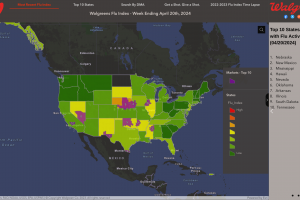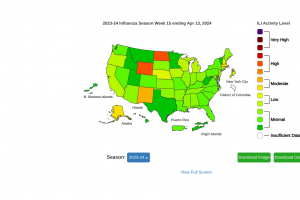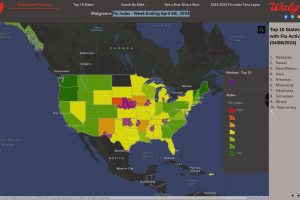Influenza Season 2024
Influenza Season 2024
While seasonal influenza (flu) viruses are detected year-round, the exact timing and duration of any flu season varies by country and influenza virus, says the World Health Organization (WHO). On March 4, 2024, the WHO published Influenza Update N° 466, confirming influenza detections have decreased globally. According to the WHO, the Pan American Health Organization (PAHO), the U.S. Centers for Disease Control and Prevention (CDC), and the U.K. Health Security Agency, what happens in one hemisphere does not necessarily predict what will happen in the other because influenza viruses change and impact populations differently. The U.S. CDC publishes preliminary flu season estimates based on data collected through FluSurv-NET.
Influenza Deaths
As of week #14 in 2024, the U.S. CDC identified 138 influenza-associated pediatric deaths during the 2023-2024 season using underlying cause-of-death codes J09–J18. The CDC confirmed that 184 influenza-associated pediatric deaths occurred in the U.S. during the 2022-2023 season. The WHO confirmed on October 3, 2023, that about 99% of children fatalities under five years of age with influenza-related lower respiratory tract infections are in developing countries. The JAMA Network published a peer-reviewed influenza mortality study that found from 1999 to 2018, there were 10,171 (95% CI, 9652-10 691) underlying respiratory deaths per year in the U.S.
Flu Season in the Region of the Americas
In March 2024, the WHO reported that influenza activity remained moderate in the Central American and Caribbean countries, and In tropical South America, influenza activity remained low. In the temperate zones of the southern hemisphere, indicators of influenza activity were reported at low levels or below the seasonal threshold in most reporting countries. Influenza activity remained within or below expected levels for this time of year in Canada and remained elevated but may have peaked in the United States of America.
Flu Season Australia
In Oceania, influenza activity decreased with influenza A(H1N1)pdm09 and influenza B viruses predominant in 2023. Australia's Department of Health and Aged Care published report No. 14 in October 2023, which stated the impact on society due to the 2023 influenza season was low. Current influenza and vaccination data posted through 2023 was inadequate to assess vaccine effectiveness this flu season. The 2022 Australian Influenza Surveillance Report provides a national influenza season summary.
Flu Season Europe
In Europe and Central Asia, influenza activity remained low overall in the most recent week but has increased over the past few weeks. Of forty reporting countries, activity was reported at medium intensity in six, low intensity in twelve, and below baseline as of week #50. Rates were increasing in multiple countries but were at levels similar to those observed in the same period in 2022. The ERVISS provides a weekly integrated epidemiological summary for influenza for the European Union / European Economic Area and the WHO European Region.
Flu Season Mexico
In the Central American and Caribbean countries, influenza activity remained moderate in the Caribbean with detections of predominantly influenza A(H1N1)pdm09 and low in Central America with detections of predominantly B/Victoria lineage viruses.
Flu Season South Africa
Public Health South Africa reported in December 2023 that influenza activity peaked during epidemiological week #22 (June 4, 2023). The previous mean onset of the influenza season from 2005-2019 was week #17 (3rd week of April). As of December 1, 2023, Influenza infections were dominated by A(H3N2) (98%) and had an overall detection rate of 12%. For the current flu season, vaccine effectiveness for any influenza in individuals of all ages was 81% [95% confidence interval (CI) 29%-95%)], and for A(H3N2), it was 76% [95% CI 10%-94%].
Flu Season 2023-2024 United States
The U.S. CDC published an updated respiratory disease season outlook on March 29, 2024, stating that most states have reported diminishing flu cases, while some states' weekly flu indicators remain elevated. Influenza activity in the U.S. during the 2022-23 season (October 2, 2022 – September 9, 2023) was moderately severe and occurred earlier than usual, peaking in mid-December 2022, says the CDC. Of all deaths reported by the National Center for Health Statistics from October 2, 2022, to September 9, 2023, 9,697 (4%) listed influenza. The highest weekly count of deaths due to influenza was 1,048 (1.6% of all deaths), occurring the week ending December 17, 2022. The CDC confirmed that 178 influenza-associated pediatric fatalities have been reported during the 2022-2023 flu season. The mean age at death was seven years, and about 83% of these children were not fully vaccinated. Among 5,390 hospitalized adults with information on underlying medical conditions, 96.8% had at least one reported underlying medical condition; the most commonly reported were hypertension, cardiovascular disease, metabolic disorder, and obesity. The flu shot vaccination status was not disclosed. The CDC's Clinician Outreach and Communication Activity webinar on August 31, 2023, presented an Update for Pediatric Providers regarding the 2023-2024 Recommendations for Influenza Prevention and Treatment in Children. The CDC published an Influenza Summary Update map.
The Walgreens Flu Index® map highlights local flu activity in the U.S. It was last updated in March 2024. The Texas Department of State Health Services respiratory virus dashboard and weekly respiratory virus surveillance report were launched in 2024.
Flu Season United Kingdom
In the U.K., influenza positivity remained stable at 1.8% in week #47 compared to 1.8% in the previous week. This week's overall flu hospital admission remained low at 0.39 per 100,000 population, compared to 0.29 per 100,000 last week. Children under five years continue to have the highest number of hospital admissions, but this number has decreased this week. No influenza-confirmed outbreaks were reported in England. As of November 24, 2023, the provisional proportion of people in England who have received the 2023 to 2024 influenza vaccine was posted at this UKHSA link.
Influenza Vaccines
Flu shots news for the 2023-2024 influenza season is published by Precision Vaccinations.
RSV Season
Respiratory syncytial virus (RSV) season 2023 trends are published by Precision Vaccinations.
Influenza, RSV, SARS-CoV-2 Coinfections
Overall, tests revealed that coinfections with two or more viruses occurred in 1.33% of positive results and .55% of the studied samples. The positivity rates varied by the viruses involved, ranging from .38% in adults for SARS-CoV-2 and RSV to 2.28% in adults for influenza A and SARS-CoV-2. However, coinfection rates in the pediatric group were higher than in the adult population for all three viruses. Pratt noted that his team was surprised by the high 6% coinfection rate of SARS-CoV-2 and influenza A in those under 21.





